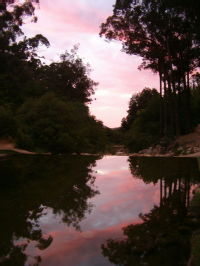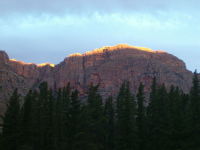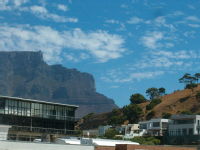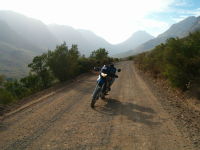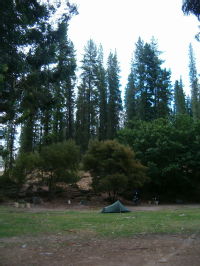All entries for Saturday 28 January 2006
January 28, 2006
Travel Report: Eating mud in the Karoo
Follow-up to Travel Report: In the Cederberg Mountains from Transversality - Robert O'Toole
Two phrases became imminent as I hit the desert floor:
"How did I get here?"
And simply:
"Oh bugger!"
The latter of which was voiced to an on-looking audience of red sand, rolling bushes, and a small flock of bemused sheep.
I instantly knew my exact location: lying across the edge of the dirt track between Loriesfontein and Brandvlei, eating mud in the vast emptiness of the Great Karoo arid plateau, in the North West of South Africa, in a small amount of trouble. And my bike? In a similar position, but with its left handlebar embedded 20cm into the ground, engine still running, and seemingly intact.
Upon getting to my feet, the pain of a rapidly swelling wrist failed to distract me from the recurring question: exactly how did I get here?
I can give a few simple but insufficient reasons. Firstly, I took the wrong road out of Calvinia to Brandvlei. This can't be as stupid as it sounds. I made the same mistake last time I traveled to Upington in the Kalahari. This left me with 200 kilometers of dirt to cross. Having done the same trail before (in a Hilux), this should not have been a problem. In fact it was what I came to South Africa to do. This too was a factor that led me to this position, standing in the muddy edge of a remote desert track.
My aim was to ride long distance on the empty back roads, over gravel and sand, skipping across the corrugations. Moderately difficult riding, but much more enjoyable than churning through the mud of Salisbury Plane. The ride had indeed met up to its promise, and in fact included one of the most enjoyable corners I had ever traversed: a steep rise and adverse camber, with corrugations and loose sand causing the rear wheel to lose grip and slide outwards. Only by standing up and controlling the balance of the bike carefully did I get the required traction to power round the bend.
After almost 160 kilometers of getting really good at riding these conditions, spotting the good tracks and the bad tracks, seeing the colour of the dirt change between yellow, grey and red, I came to something quite unexpected: mud, inglorious mud.
At a very definite point in the track, its colour changed from soft yellow to dark brown. That point was only 35km from the tarred road at Brandvlei. Worse still, I didn't have enough petrol to turn back to Calvinia.
Before making a decision, I spent a few minutes admiring the line in the sand – a wonder of meteorology. There was a clear and distinct point at which the rain had not reached, marked by a solid line. When it does rain in these areas, it is usually quite localised. Not the all encompassing blanket drizzle of England, but rather small patches of intense downward driving rain. Sometimes the rain is capable of denting car roofs.
The sky all around was clear. The heat was burning. The mud would be drying fast. How localised was the rain? Perhaps it just covered a short stretch of road. The alternative being too terrible, 35km of muddy hell, I decided to be optimistic and have a go.
Standing up on the pegs and keeping down to 20kph, I did well and slithered through several small pools. It was just like the ride to Stonehenge – heroic stuff ending in the bike becoming cross rutted in a deep pool, front wheel heading in the opposite direction to the rear. My clothes were fortunate that I managed to make it beyond the deep mud before bailing out.
The bike was also almost undamaged. I paused for a few minutes, and then un-strapped my Ortlieb dry bag from the back. This reduced the weight and made lifting the 185kg bike possible. But first I had to dig the left side of the bars out of the mud. A big gloop of mud had forced its way around the plastic hand protectors, which were undamaged. However, the clutch lever had snapped half way along, in exactly the correct position to leave it rideable.
Once the handlebars were unearthed, I turned them so that I could pivot the bike around the wheel. With a single movement it was up. I extended the sidestand, which found firm ground. By this time the bike was pointing in entirely the wrong direction – back into the mud. There was no other option but to start the engine, hand change it into first, and walk it back through the pool. Once on the other side, I returned for my luggage and reloaded it.
And then Pieter the farmer arrived, perhaps tipped-off by his sheep that something odd was going on. Mud was respectfully forgotten for a while as we chatted about farming and its problems. Above all we celebrated the rains, good for the lands and hence for the sheep. Even more so because these were the first since last March, and the heaviest in three years. He politely apologised for my bad luck in being a victim of his good fortune. Perhaps this may have also been a motivation behind his generosity in helping me.
But before we got to the business of finding a solution to my immediate problem, we talked politics and economics. Specifically, the issue of subsidies. Pieter works hard to produce fine lamb in such a harsh climate. He employs many people who also work hard all day through the intense heat. His sheep are a big investment, and a matter of pride. But the world is not fair to Pieter and his people. In translating from his native Afrikaans to English he struggled to find the correct phrase. I suggested "cannot compete". There was however one word that he knew perfectly well: "subsidies". In the now distant past, South African farms received subsidies. This at least gave a select few (white owned) farms a small chance of competing with the heavily subsidised EU and USA. Economic pressures, the impositions of lenders and donors, and political changes, have left all farmers in SA equally defenseless. Pieter has done well to find a niche market, selling quality lamb to the Islamic market. But it is still a struggle. I explained that most UK politicians wish to abolish subsidies. I blamed the French, which always seems to go down well. However Pieter rightly pointed to the Americans as being the real and immovable obstacle.
At which point I said "oh well, at least you've had good rain". We laughed again at our opposite fortunes, and returned to the pressing issue of 35km to Brandvlei.
As he had recently driven from that direction, and possessing a farmers acute memory of physical conditions, Pieter could give me a detailed description of every obstacle: three large pools, a broken concrete dish drain, and "that awful red stuff". But he knew that the road was drying fast, assisted by the sun and the wind, and hence he was sure that I could make it through. In fact he was determined that I would do it. If necessary, he said, he would help to push the bike through himself. Perhaps he assumed that I am much tougher than I really am? I had said that I am from a town near Rugby. That always seems to impress South Africans disproportionately. Anyhow, he was confident, and even offered to lead me through in his pick-up truck.
With the back of the truck reloaded with farm workers and a single bleating sheep, Pieter led the way. I knew that I was slowing him down, although not by much, as the road was so bad that even a 4×4 had to go slow when fully loaded. And so I followed, most of the time with a single foot on the ground to prevent the back from sliding too far. Too pass through the really difficult sections, I paddled with both feet down. The knobbly Metzeler Sahara front tyre gave good grip, but the dual purpose Bridgestone Trailwing at the rear was almost useless. It slithered around promising to dump me back onto the ground. Despite this, I continued.
The technique proved most effective. After about 15km, Pieter stopped to tell me the worst was over. And it was true that, as he had promised, the road was drying fast. At this point he left me to check on a rain gauge off in the bush – a rare thing for him to do. With the promise that he would not be far behind, I continued with caution.
And then came the "awful red stuff"'. This was the red sandy soil more usually found in the Kalahari region further north. As I reached the edge of the transition in colour, I slowed to around 10kph. It seemed fine for a while, until I came to the first pool of water. I found a drier path to the right, paddling through with both feet and, most alarmingly, with the rear wheel being sucked ever deeper into the mud. I could feel the sudden halting of my forwards motion as the mud came over the wheel rim, clogging the spokes. Bloody awful red stuff.
This happened on three occasions, each as mighty a struggle as the last. The only way to escape the grip of the mud was to rock the bike backwards and forwards, whilst revving the engine hard and using the clutch to release bursts of power at just the right point. This worked, but was not at all easy.
As I passed out of the red stretch of track the small town of Brandvlei appeared in the distance, along with a large truck, complete with suitably tractor style tyres. I knew that he would make it through, but would the track surface survive his passage? Maybe I was lucky to have got through before him.
The last few kilometers were done at greater speed, but not without a few more slides of the back wheel. And then I reached the tar. As Pieter had promised, I made it through. I rubbed the mud away from the clock on the dashboard. 35km had taken me an hour and a half. But it had been a challenging and fascinating time.
Part 3, Apartheid geography today
Travel Report: In the Cederberg Mountains
I have a great new discovery, for which I make several astounding claims. A newly revealed holistic therapy. A miracle cure for both body and mind. Really, itís true, Iím not trying to con you out of money, or sign your soul away to some mad new religion.
At least it did work for me. See if you think it sounds like a panacea. Here is what I prescribe…
The treatment itself is simple, but with several necessary and arduous precursors. Let's start with the final and most pleasant stage of the process. You must be immersed to the shoulders in the warm and clean waters of a mountain stream. A wide and calm pool at the side of a ford is a prime location for this. Then you must stand on one foot, balanced perfectly on an appropriately sized boulder. You then spin slowly in a clockwise direction. A velvety carpet of moss may assist in the perfection of this maneuver.
This slow rotation allows for the rhythmic apperception of a horizon of golden and red cliff faces, fronted by giant cedar trees, and topped with a bright and clear blue sky. Whilst at every point in the rotation, the sweet cedar aroma, and the pulsating buzz of millions of insects, remains a constant intensity.
One should also try to ignore the occasional curious fish swimming in close proximity. Treat it with a certain Buddhist indifference.
Does that sound good? Do you want to have a go? Recall that I described this as being only the final stage in the process. Remember those arduous but necessary precursors?
To start with, you must fly to Cape Town. There are means of transport less torturous than British Airways, but I suspect that the body and mind must be thoroughly broken before they can gain salvation through the cure described above. Paper thin seats with no leg room are the most efficient means to inflict the required degree of pain. To make things worse, become separated from your beautiful wife and baby at Johannesburg, for they have other plans.
At Cape Town, take the shuttle bus from the airport, allowing the talkative driver to both amaze and terrify you. On the one hand it is said to be a city of harmony, integration and culture. Whilst on the other, you are told not to go out after 5pm (sunset is currently 8pm), or you will definitely without a doubt meet with a terrible fate.
Next, I recommend an intellectual challenge. Stay at the fine Victoria Junction Hotel in Cape Town. Take the opportunity to rigorously debate skepticism, Empiricism and theology with the philosophically adept waiter by the name of Junior. His renditions of the speeches of Martin Luther King are inspirational.
The following morning, you must collect a BMW F650 GS Dakar motorcycle from Karoo Biking. The next stage of the process consists of a journey for which only this bike is suitable. Firstly, ride out of the urban sprawl with the agility of a springbok. Then, blast up the N7 highway at 120kph, passing double-articulated trucks with ease. And finally after 200km, turn of the tar and onto the dirt. The high speed vibration of the big single cylinder engine adds a further degree of stress, particularly to the hands and feet – precisely those areas reached most immediately by the ďtherapyĒ.
The Algeria campsite in the Cederberg Wilderness Area is about 30km along the dirt road. The build up to arrival is increasingly impressive. The track winds through a mountain pass, with some moderately steep rises and descents. The surface is mostly good smooth gravel, with the occasional loose scree and exciting adverse cambered rising bend. The views forcibly distract one's attention from the task of keeping it upright and forwards flowing. But I have to say it was for me a great ride.
On reaching the camp, take of your helmet and ear-plugs, and think you have suddenly developed tinnitus. After the panic subsides, realize that the bush here is packed with insects. Loud and perfectly well synchronized insects.
Finally, you have a choice. Either set up camp in one of the spacious shady spots (they also have some chalets), or proceed directly to the therapy pool. I chose the latter option, fully clothed (remove helmet and heavy biker boots first).
As someone once said, this is how religions get started.
Onto part 2, Eating mud in the Karoo
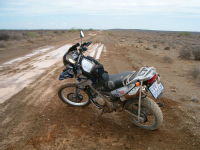
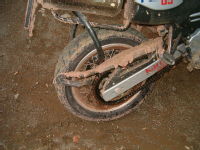
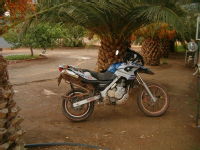
 Robert O'Toole
Robert O'Toole

 Please wait - comments are loading
Please wait - comments are loading
